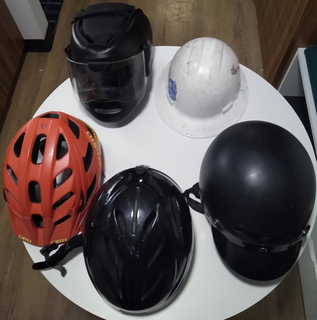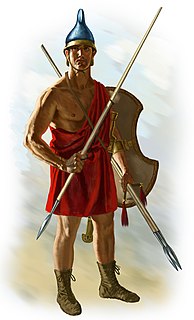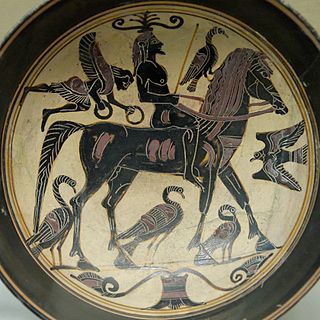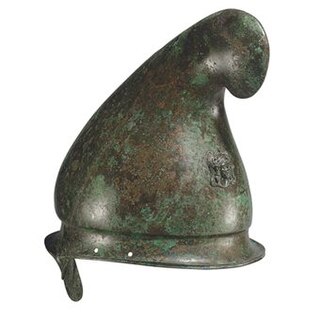
Hoplites were citizen-soldiers of Ancient Greek city-states who were primarily armed with spears and shields. Hoplite soldiers utilized the phalanx formation to be effective in war with fewer soldiers. The formation discouraged the soldiers from acting alone, for this would compromise the formation and minimize its strengths. The hoplites were primarily represented by free citizens – propertied farmers and artisans – who were able to afford a linen armour or a bronze armour suit and weapons. Most hoplites were not professional soldiers and often lacked sufficient military training. Some states maintained a small elite professional unit, known as the epilektoi ("chosen") since they were picked from the regular citizen infantry. These existed at times in Athens, Argos, Thebes, and Syracuse, among others. Hoplite soldiers made up the bulk of ancient Greek armies.

A helmet is a form of protective gear worn to protect the head. More specifically, a helmet complements the skull in protecting the human brain. Ceremonial or symbolic helmets without protective function are sometimes worn. Soldiers wear combat helmets, often made from Kevlar or other lightweight synthetic fibers.

A peltast was a type of light infantryman, originating in Thrace and Paeonia, and named after the kind of shield he carried. Thucydides mentions the Thracian peltasts, while Xenophon in the Anabasis distinguishes the Thracian and Greek peltast troops. The peltast often served as a skirmisher in Hellenic and Hellenistic armies. In the Medieval period, the same term was used for a type of Byzantine infantryman.

The Agrianes or Agrianians, were a tribe whose country was centered at Upper Strymon, in present-day central Western Bulgaria, at the time situated north of the Dentheletae. Per Strabo the source of the river Strymon was within Agrianes' territory. In the times of Philip II, the territory of the Agrianes was administered by Pella. They were crack javelin throwers and an elite unit of Alexander the Great's light infantry, who fought under the command of General Attalus.

The Italiotes were the pre-Roman Greek-speaking inhabitants of the Italian Peninsula, between Naples and Sicily.
Plumbatae or martiobarbuli were lead-weighted darts carried by infantrymen in Antiquity and the Middle Ages.

Hippeis is a Greek term for cavalry. In ancient Athenian society, after the political reforms of Solon, the hippeus was the second highest of the four social classes. It was composed of men who had at least 300 medimnoi or their equivalent as yearly income. According to the Timocratic Constitution the average citizen had a yearly income of less than 200 medimnoi. This gave the men who made 300 medimnoi the ability to purchase and maintain a war horse during their service to the state.

A galea was a Roman soldier's helmet. Some gladiators, specifically myrmillones, also wore bronze galeae with face masks and decorations, often a fish on its crest. The exact form or design of the helmet varied significantly over time, between differing unit types, and also between individual examples – pre-industrial production was by hand – so it is not certain to what degree there was any standardization even under the Roman Empire.

A winged helmet is a helmet decorated with wings, usually on both sides. Ancient depictions of the god Hermes, Mercury and of Roma depict them wearing winged helmets, however, in the 19th century the winged helmet became widely used to depict the Celts. It was also used in romantic illustrations of legendary Norse gods and heroes. The motif, along with the horned helmet, became a clichéd signifier of the Northern warrior.

The pileus was a brimless, felt cap worn in Ancient Greece, Etruria, Illyria, Pannonia and surrounding regions, later also introduced in Ancient Rome. In the 5th century BC a bronze version began to appear in Ancient Greece and it became a popular infantry helmet. It occasionally had a horsehair crest. The Greek πιλίδιον and Latin pilleolus were smaller versions, similar to a skullcap. The plis worn today in Albania and Kosovo is thought to originate from a similar felt cap worn by the ancient Illyrians.

The Boeotian helmet was a type of combat helmet used in Ancient Greece during the classical and Hellenistic periods, as well as in Ancient Rome; it possibly originated in the Greek region of Boeotia.

The "Illyrian type helmet" is a style of bronze helmet, which in its later variations covered the entire head and neck, and was open-faced in all of its forms. It originated in Peloponnese, ancient Greece, and was developed during the 8th and 7th centuries BC. Accurate representations on Corinthian vases are sufficient to indicate that the "Illyrian" type helmet was developed before 600 BC. The helmet was misleadingly named as an "Illyrian" type due to many early finds coming from Illyria.
The history of Illyrian warfare of the Illyrians spans from the beginning of the 2nd millennium BC up to the 1st century AD in the region of Illyria and in southern Italy where the Iapygian civilization flourished.

The Attic helmet was a type of helmet that originated in Classical Greece and was widely used in Italy and the Hellenistic world until well into the Roman Empire. Its name is a modern historiographic convention: "Terms such as Illyrian and Attic are used in archaeology for convenience to denote a particular type of helmet and do not imply its origin".

The history of Thracian warfare spans from the 10th century BC up to the 1st century AD in the region defined by Ancient Greek and Latin historians as Thrace. It concerns the armed conflicts of the Thracian tribes and their kingdoms in the Balkans. Apart from conflicts between Thracians and neighboring nations and tribes, numerous wars were recorded among Thracian tribes.

The history of Dacian warfare spans from c. 10th century BC up to the 2nd century AD in the region defined by Ancient Greek and Latin historians as Dacia, populated by a collection of Thracian, Ionian, and Dorian tribes. It concerns the armed conflicts of the Dacian tribes and their kingdoms in the Balkans. Apart from conflicts between Dacians and neighboring nations and tribes, numerous wars were recorded among Dacians too.

The Phrygian helmet, also known as the Thracian helmet, was a type of helmet that originated in ancient Greece and was widely used in Thrace, Dacia, Magna Graecia and the Hellenistic world until well into the Roman Empire.

Illyrian weaponry played an important role in the makeup of Illyrian armies and in conflicts involving the Illyrians. Of all the ancients sources the most important and abundant writings are those of Ennius, a Roman poet of Messapian origin. Weapons of all sorts were also placed intact in the graves of Illyrian warriors and provide a detailed picture for archaeologists on the distribution and development of Illyrian weaponry.

The appearance of Celts in Transylvania can be traced to the later La Tène period . Excavation of the great La Tène necropolis at Apahida, Cluj County, by S. Kovacs at the turn of the 20th century revealed the first evidence of Celtic culture in Romania. The 3rd–2nd century BC site is remarkable for its cremation burials and chiefly wheel-made funeral vessels.

The Late Roman ridge helmet was a type of combat helmet of Late Antiquity used by soldiers of the Late Roman army. It was characterized by the possession of a bowl made up of two or four parts, united by a longitudinal ridge.


















